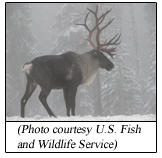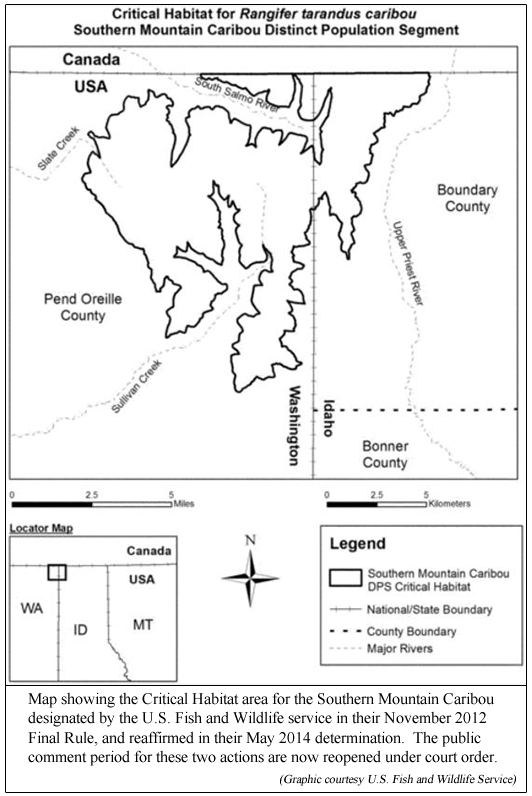Pend Oreille County, Washington
 Under
orders of the U.S. District Court in Idaho, the
U.S. Fish and Wildlife Service is reopening the
opportunity for public comment on its November
2012 Final Rule, and its subsequent May 8, 2014
proposed rule regarding the Southern Selkirk
Mountains population of woodland caribou.
Under
orders of the U.S. District Court in Idaho, the
U.S. Fish and Wildlife Service is reopening the
opportunity for public comment on its November
2012 Final Rule, and its subsequent May 8, 2014
proposed rule regarding the Southern Selkirk
Mountains population of woodland caribou.How to go about submitting a public comment, and the sort of comments the Fish and Wildlife Service is seeking from the public is all detailed toward the end of this article, and the reader may skip directly there if desired.
As far as why the public comment period is being reopened, that story involves some Boundary County caribou history, also the involvement of various groups with differing opinions on how those caribou should be managed, a lawsuit, petitions being filed, and the U.S. Fish and Wildlife Service studying, analyzing, and issuing its various determinations and rulings on the caribou.
That part of the story goes like this . . .
Short history of Selkirk Caribou and recent legal issues
One small group of the Selkirk Mountains population of woodland caribou has long wandered through the Selkirk Mountains of Boundary County, and is considered to be the only remaining herd of mountain caribou in the lower 48 states, and the southernmost caribou group in North America.. This particular group is called a "transboundary population" of the caribou, since the area it roams includes Boundary County in Idaho and Pend Oreille County in Washington, along with crossing the border into parts of southern British Columbia, Canada.
The population of Boundary County's transient caribou herd was estimated in 2012 to be less than 30 animals. Boundary County's caribou group is one of a collection of groups (all the 14 other groups being located in Canada) that Fish and Wildlife proposed in 2014 to be defined as the Southern Mountain Caribou Distinct Population Segment. The various groups of caribou comprising this designation, with which the Boundary County group is affiliated, was estimated to have a total 1,657 animals in 2013.
The small group that ranges through Boundary County and Pend Oreille County in Washington is no stranger to controversy, or to the U.S. court system. The group was emergency listed in 1983 as "Endangered" under the Endangered Species Act of 1973, with a formal ruling designating the group as "Endangered" in 1984.
U.S. Fish and Wildlife, environmental groups, and the courts
Back in 2011, acting on a petition that had been filed by environmental groups asking that critical habitat be established for the southern Selkirk Mountains woodland caribou, the U.S. Fish and Wildlife service initially considered establishing an area of 375,552 acres for that critical habitat, an area that included a huge swath through Boundary and Bonner Counties in Idaho, which included virtually all of the Selkirks between Priest Lake and the Kootenai Valley, along with a large area in Pend Oreille County, Washington. However, in November 2012, after much controversy, discussion, public meetings, and deliberation, the Fish and Wildlife Service issued its final determination that the caribou critical habitat would be a significantly smaller 30,010 acres, with only a small remote corner in northwest Boundary County being part of that designation. Most of the 30,010 acre habitat area as currently designated is in Pend Oreille County, Washington, with only approximately 1/4 of the habitat lying within Boundary County.
In January 2013, two months after Fish and Wildlife decided to cut the caribou's critical habitat area to the much smalller acreage, a coalition of six environmental groups filed a notice of intent to sue the Fish and Wildlife Service regarding the decision to reduce the critical habitat. That suit was formally filed in September 2013.
In the meantime, earlier in 2012, Fish and Wildlife had also received a petition from the Pacific Legal Foundation, representing Bonner County, Idaho and the Idaho State Snowmobile Association, asking that Fish and Wildlife delist the southern Selkirk Mountain population of woodland caribou from its "endangered" designation. In response to that petition, in May 2014 Fish and Wildlife stated, "After review of the best available scientific and commercial information, we find that delisting the species is not warranted."
In that same finding, Fish and Wildlife went on to address three other issues:
1. They announced in this finding their determination that the southern population of the Selkirk Mountains Caribou would be considered a part of the larger, newly-defined Southern Mountain Caribou Distinct Population Segment, and that
2. The status of this newly-defined Southern Mountain Caribou Distinct Population Segment would be "Threatened" under the Endangered Species Act.
3. Fish and Wildlife reaffirmed that the 30,010 acres designated as critical habitat for caribou back in their November 2012 Final Rule would continue to be applicable for the newly-defined Southern Mountain Caribou Distinct Population Segment.
(Story continues below this graphic)

Environmental group lawsuit begins
The lawsuit the six environmental groups had filed in September 2013 moved ahead, ultimately being heard in United States District Court before Judge Edward J. Lodge, U.S. District Judge for the District of Idaho. (The six groups who brought the suit: Center for Biological Diversity, Defenders of Wildlife, Conservation Northwest, Idaho Conservation League, Selkirk Conservation Alliance, and The Lands Council).
As the lawsuit got underway, other groups intervened in the action on behalf of the Fish and Wildlife Service, including the Kootenai Tribe of Idaho, Boundary County, Idaho Governor C.L. "Butch" Otter, Bonner County, and the Idaho State Snowmobile Association, Inc.
In the suit, the environmental groups claimed that, in its November 2012 Rule designating the much smaller caribou critical habitat area, the Fish and Wildlife Service violated the Endangered Species Act in two ways. The alleged violations were : 1) the Final Rule's critical habitat designation was arbitrary and capricious, because the Fish and Wildlife Service failed to explain how the limited amount of critical habitat designated would be sufficient to recover the affected population of caribou, and 2) Fish and Wildlife failed to provide public notice and comment on the substantially revised critical habitat designation before issuing its Final Rule.
The Fish and Wildlife Service and the above-listed intervening groups countered that the Fish and Wildlife Service satisfied the requirements of the Endangered Species Act, that the critical habitat designation was rationally based on the best available scientific data, and that the court should uphold the Final Rule's smaller critical habitat designation. The defendants further submitted that Fish and Wildlife was not required to provide an additional notice and comment period prior to issuing the Final Rule because they had already provided for extensive public commenting before the final rule was announced.
The Judge's decision and order
On March 23, 2015 Judge Lodge issued his written decision and order on the case. While not ruling directly regarding the environmental groups' contention that the critical habitat designation was "arbitrary and capricious," he agreed with them that there were shortcomings in the public comment process. Judge Lodge ruled that the final rule determined by Fish and Wildlife involved a "fundamental shift" in reasoning that occurred after closure of the public comment period, a shift that could not have been anticipated before the public comments were closed, and that the final rule was based partly on an unanticipated line of logic which the public did not have opportunity to review and comment on. Further, he ruled that Fish and Wildlife based its final decision to reduce the designated critical habitat in part on materials not mentioned in the initially proposed rule.
Judge Lodge made it a point to say in his ruling that "The Court does not fault the ultimate conclusion reached in the Final Rule on this issue. In fact, the Court agrees with the Defendants that the FWS can and should undertake such reassessments of its positions when presented with better scientific evidence," and that "The Court makes clear that it is not finding here that the FWS’s reasoning is unsound or arbitrary and capricious." Rather, he indicated that the Fish and Wildlife error was a procedural error, as the agency failed to "provide a period of public review and comment on the Final Rule’s critical change in reasoning, however logical that reasoning may ultimately turn out to be."
He ordered that Fish and Wildlife correct this by providing a period for public comment, now with all information used in their determination being publicly available, and that the agency consider anew the critical habitat determination, taking into consideration public comments provided in this new comment period.
In response to court ruling, comment period is reopened
In responding to that order, the U.S. Fish and Wildlife Service has now reopened the public comment period on the November 2012 Final Rule cutting the caribou's critical habitat area, and on the May 2014 proposed rule which defined the Southern Mountain Caribou distinct population segment, designated that group as "Threatened" under the Endangered Species Act, and reaffirmed the designation of the smaller size 30,010 acres of critical habitat. Public comment in this new, court-ordered comment period will be accepted until the closing date of May 19.
How to submit a comment
Comments can be made in a couple of ways:
1. Electronically: To submit a comment electronically, go to
https://www.regulations.gov/#!submitComment;D=FWS-R1-ES-2012-0097-0546
and enter your comment.
2. Hard copy: Submit via U.S. Mail or hand deliver your comment to:
Public Comments Processing
Attn: FWS-R1-ES-2012-0097
Division of Policy, Performance, and Management Programs
U.S. Fish and Wildlife Service, MS: BPHC
5275 Leesburg Pike
Falls Church, Virginia 22041-3803
Fish and Wildlife plans to post all comments received at http://www.regulations.gov
You can read comments already submitted in past comment periods and from the newly reopened comment period at https://www.regulations.gov/#!docketDetail;D=FWS-R1-ES-2012-0097
What kind of comments are they looking for?
"We are seeking written comments and information from appropriate Federal and State agencies, the scientific community, and any other interested party during this reopened comment period on our proposed rule that was published in the May 8, 2014, Federal Register(79 FR 26504)," Fish and Wildlife said in their information on the new comment period.
Fish and Wildlife indicates that they are seeking in particular comments on the November 2012 designation of the critical habitat. "This information will be used to finalize the critical habitat designation for the Southern Mountain caribou distinct population segment."
They further indicate that there is no need to resubmit comments that were already submitted for any of the previous comment periods. "We have incorporated them into the public record as part of this comment period, and we will fully consider them in our final determination."
They want more than simply if you're for it or against it
Finally, they note that they are looking at the submitted public comments for more than just support or opposition to proposed caribou policies. They are encouraging comments that present scientific, factual, and specific information that would be helpful in making an objective determination on the caribou issues detailed above. Fish and Wildlife information on the new comment period states: "Please note that submissions merely stating support for or opposition to the action under consideration without providing supporting information, although noted, will not be considered in making a determination, as section 4(b)(2) of the Act directs that critical habitat determinations must be made 'on the basis of the best scientific data available.' "